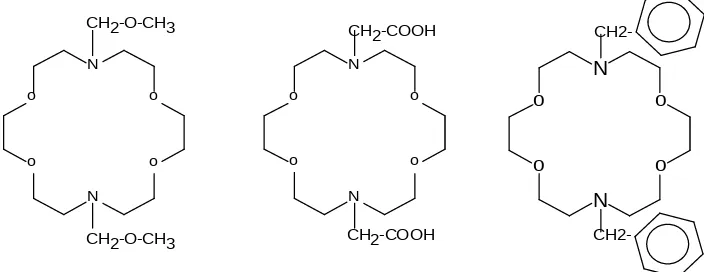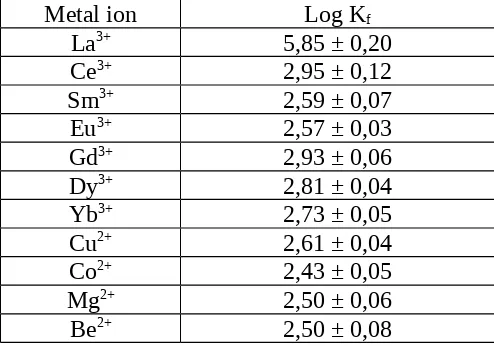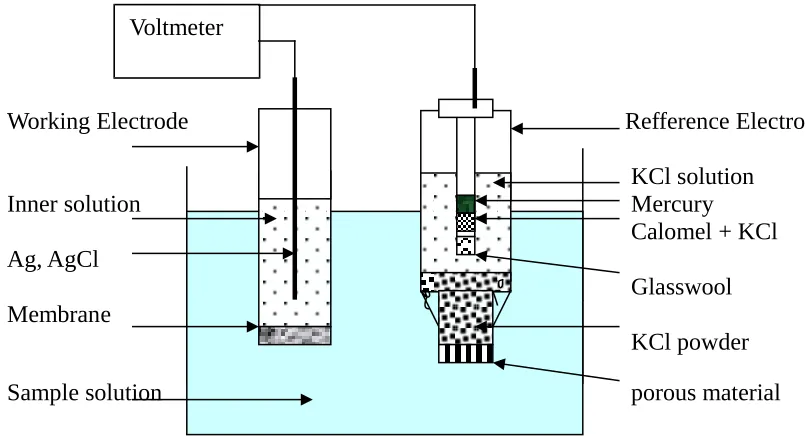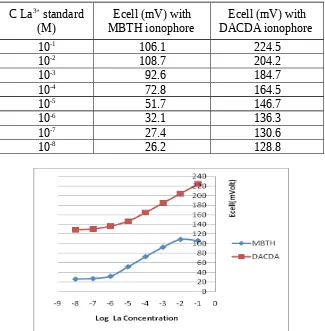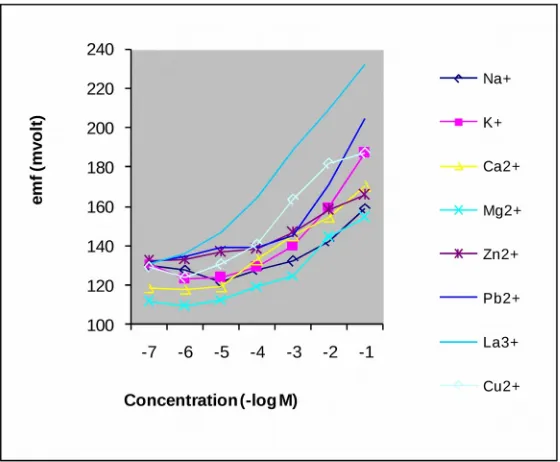STUDY OF LANTHANUM COMPLEXATION WITH MACROCYCLES COMPOUND AND THEIR CHARACTERISATION AS ION SELECTIVE ELECTRODE
FOR ANALYSIS OF LANTHANUM IN MONASIT MINERAL
Oleh : Suyanta, Rr. Lis Permana Sari, and Sunarto Email : ytakimiauny@yahoo.com.au
Abstract
The aim of this research is to study the lanthanum (III) ion selective electrode (La-ISE) potential response which follows the Nernst equation. The characters of the electrode studied are: response time, life time, detection limit, dynamic range and selectivity. The electrode having a good performance as La-ISE is applied as working electrode for detection of lanthanum ion in sample solution.
Construction of La-ISE is started with the preparation of the membrane, which was made from a mixture of 10 mg of 1,10 diaza 18 crown 6 diacetic acid (DACDA) or 3-methyl-2-benzothiazolinone-hydrazone hydrochloride (MBTH), 45 mg of polyvinyl chloride, 90 mg of nitrophenyl octhyl ether (NPOE) as plasticizer, and 5 mg of potassium tetrakis-chloro phenyl borate (KTCPB) in 3 mL of tetrahydrofuran(THF). This membrane solution was evaporated on a 1.5 x 4 cm2 glass for 24 hours. The membrane then glued to the end of the electrode tube. The
electrode was filled with a mixture of reference solution containing 10-3 M La(III) and 10-3 M
KCl, and Ag/AgCl internal reference electrode which were connected with coaxial cable. The electrode was immersed in 10-3 M La(III) solution for 24 hours beforehand. Two electrode
membrane potential was measured in La(III) solution by potentiometry system. First membrane contain DACDA ionophore and second membrane contain ionofor 3-methyl-2-benzothiazolinone-hydrazone hydrochloride (MBTH) ionophore.
In general, optimum responses were obtained using membrane with a composition of 30.1% PVC, 59.7% NPOE, 6.6% DACDA or 5.4 % MBTH, and 3.3% KTCPB. The membrane
had stable responses in pH range between 3 and 9. Good responses were obtained using 10-3 M
La(III) internal solution, which produced relatively high potentials. The electrode showed relatively good performances. The electrode had a response time of 27.14 ± 4.79 seconds and could be used for 50 days. The linear range was between 10-6 M and 10-1 M with a detection
A. INTRODUCTION
Rare earth elements are known as important inorganic compounds, because of their properties, especially their strong magnetic property. One of the important elements is lanthanum. The available methods for low level determination of rare earth ions in solution include, ICPMS, ICPAES, and X-ray fluorescence spectrometry, etc (Houk, R.S. et.all, 1980). These methods are either time consuming, involving multiple sample manipulation and too expensive for most analytical laboratories.
Ion selective electrode (ISE) in potentiometry is one method of analysis that is simpler and inexpensive but can used as a good method. Ion selective electrodes with neutral carriers were developed for some elements especially for alkali, earth alkali and transition elements. They are successful methods for analysis. For rare earth elements, a very little work on the system have been done by some researcher. Only a few reports are found in the literature on the preparation of ore rare earth ion selective electrodes (Choudhury et.all, 1996). For this reason, we tried prepare an ion selective electrode for rare earth elements, especially for lanthanum.
Macrocycle compounds have properties to form complex compounds with some metals. In this case, macrocycles function as ligand (Zolotov, Y.A., 1998 ). For example, crown ethers with alkali and earth alkali metal ions to form very specific complex compounds. Macrocycles with N (nitrogen) element usually form complex compounds with transition elements. Chang C.A. and Ochaya, synthesized the macrocycle compound lariat diaza 18 C 6
(1,10-diaza-4,7,13,16-tetraoxacyclo-octadecane-N,N’-diacetic acid and
1,7-diaza-4,10,13-trioxacyclooctadecane-N,N’-diacetic acid) and studied complexation with rare earth elements. They concluded, these compounds are selective reagents for lanthanide ions. For this reason, we tried make an ion selective electrode for lanthanum with the compound lariat diaza 18 C 6. We focused on two kinds of macrocycle compound with structures given in figure 1.
o
Ganjali et.all. (2005) was synthesis 4-metil-hidrazino benzotiasol (MHBT) compound from 4-methyl-2-aminobenzothiasole hydrobromide and hydrazine hydrate. This compound have complex constant value with lanthanum ion that higher than another ions. So the compound can be selected reaction to lanthanum ion. The 4-metil-hidrazino benzotiasol (MHBT) compound as in organic ligant that has electron donor from S dan N atom. The structure of the compound can be shapeted in figure 2.
CH3
S
N
NH
NH2
Figure 2: Struktur MHBT
MHBT compound can react with some ions to form complexes compound. The value complesxes constant (Kf) was studied by Ganjali MR (2005). The value complesxes constant are
presented in Table 1.
Table 1: Complexes constant value of metal ions with MHBT in acetonitrile solvent.
Metal ion Log Kf
La3+ 5,85 ± 0,20
Ce3+ 2,95 ± 0,12
Sm3+ 2,59 ± 0,07
Eu3+ 2,57 ± 0,03
Gd3+ 2,93 ± 0,06
Dy3+ 2,81 ± 0,04
Yb3+ 2,73 ± 0,05
Cu2+ 2,61 ± 0,04
Co2+ 2,43 ± 0,05
Mg2+ 2,50 ± 0,06
Be2+ 2,50 ± 0,08
From the Kf value, lanthanum ion have value of Kf is 5,85 ± 0,20. This value show that a
higher value than Kf value of some another ion. Hal ini menunjukkan bahwa MHBT dapat
membentuk kompleks yang paling stabil dengan ion lantanum.
Figure 3: Struktur MBTH
With the similar structure, the compound can be used as active membrane in ion selective electrode, asspecilly for lanthanum ion selective membrane electrode. From the reason it wil be concent on the research. The research were with the problems :
1. How are the nernstian response from ion selective elektrode with DACDA and MBTH ionophore?
2. How are the potential response character included detection limit, response time and selectivity.
For research on ion selective electrode, some material should be added that are main matrict PVC selektofor, plastisezer nitrophenyl octyl ether (NPOE), anionicside potasium tetrakis-chlorophenyl borate (KTCPB) and organik solvent tetrahydrofurane (THF). The electrode development type is tube electrode, with inner solution system.
The electromotive force (emf) a cross this cell is the sum of all individual potential contributions. The emf value of the membrane system generally dependent to membrane potential. Membrane is usually interposed between the sample and an inner reference electrolyte. It is common to divide the membrane potential (Em) into three separate potential
contributions, namely the phase boundary potential (EPB) at both interfaces and the diffusion
potential (EDiff) within the ion selective membrane.7
Em = EDiff + 2 EPB ……… 1
For ion selective electrode, the membrane internal diffusion potential is zero if no ion concentration gradients occur. The concentration of ion in the inner solution is constant, so the phase boundary potential in inner interface is constant. From the assumption value Em is:
Em = EConst + EPB ……… 2
Where EPB is the phase boundary potential at the membrane sample interface.
The value of phase boundary potential can be derived from a basic thermodynamic consideration. First, the electrochemical potential, (µe) , is formulated for the aqueous phase and
organic phase. Finally, the membrane potential can derived and result the equation as follow :
Pot
B
A
K
A
Pot
,
B
RT
Em = Eo + --- ln ai (aq) ... 3
zF
This equation is called the Nernst equation. From the equation we can see that membrane potential is only identical with a number analyte ion activity.
B. EXPERIMENTAL B.1. Reagents
A stock solution (10-1 M) of lanthanum (III) was prepared by dissolving LaCl
3.7H2O (99.9 %
purity, Merck, Germany) in distilled water. The ionophore 1,10-diaza-4,7,13,16-tetraoxacyclooctadecane-N,N’-diacetic acid was purchased from ACROS ORGANIC, New Jersey, USA. The ionophore 3-methyl-2-benzothiazolinone-hydrazone hydrochloride (MBTH) was purchased from SIGMA Jakarta. The plasticizer of o-nitrophenyl octyl ether (NPOE) and anionic side potassium tetrakis (4-chlorophenyl) borate (KTCPB) were purchased from Fluka Chemie AG, Switzerland. Tetrahydrofuran (THF) used for dissolving the membrane components was purchased from Merck. All other chemicals used in analytical determinations were guaranted reagent grade purity.
B.2. Membrane and electrode preparation
The membrane solution was prepared by dissolving 10.0 mg 1,10-diaza-4,7,13,16-tetraoxacyclooctadecane-N,N’-diacetic acid (DACDA) or 3-methyl-2-benzothiazolinone-hydrazone hydrochloride (MBTH), 45 mg PVC, 90 mg NPOE and 5 mg KTCPB in 3 mL of THF. The solution was evaporated on a plane glass with an area of 1.5 x 4 cm2. The electrode
was prepared by gluing the electrode tube to the membrane. The inner reference electrode Ag/AgCl and the inner solution (a mixture of 10-3 M KCl and 10-3 M La3+) is set in the tube and
connected to coaxial cable. The electrode was conditioned before potentiometric measurement by immersing it into 10-3 M LaCl
3 solution for 24 hours.
B.3. Electrode system and EMF measurement
The cell configuration used for potentiometric measurement was of the type: Ag/AgCl/KCl(sat): 3 M KCl ∶∶ sample solution ∥ membrane ∥ internal filling solution / AgCl/Ag
reading on ion-meter became stable. The pH values of the sample solutions were adjusted with
NaOH and HCl/HNO3 and measured with a pH-meter. The activity of metal ion was calculated
based on their activity coefficient, , as calculated from the modified Debye Huckel equation: Log = - 0,511 Z2 [ / (1+1,5 ) ) - 0,2 ]
Where is ionic strength and Z is the valence of the concerned ion. All the EMF measurements were performed at 25 3 oC. The cell measurements are schematic in figure 4.
Working Electrode Refference Electrode
KCl solution
Inner solution Mercury
Calomel + KCl Ag, AgCl
Glasswool Membrane
KCl powder
Sample solution porous material
Figure 4: Schematic of potential cell measurement
C. RESULTS AND DISCUSSION
C.1. Response characteristics of La(III)-selective electrode
The potential response of the electrode was affected by the composition of the membrane electrode. For this reason we varied the composition of the membrane to result in a good potential response. The composition of the membrane electrode can be seen in table 2.
Table 2. Composition of the membrane electrode
No PVC (mg) NPOE (mg) Ionophore (mg) KTCPB (mg) Slope
1 45.5 (30.11%) 90.2 (59.69%) 10.0 (6.62% of (DACDA) 5.4 (3.57%) 19.531.62
2 51.8 (30.22%) 100.5 ( 58.63) 9.3 ( 5.43% of MBTH) 9.8 (5.72%) 19.381.54
From the data, it can be seen that the general composition about with 5 % ionophore, 30 % PVC, 60 % NPOE and 3-5 % KTCPB gave a Nernstian response with a slope about 19.4 mV/decade. With the membrane electrode composistion we measure the potential cell response. The potential
data are collected in table 3 and then make the graphic of correlation between lanthanum concentration and potential response. The graphic is posted in figure 5.
Table 3. Ecell ISE La with MBTH and DACDA ionophore
C La3+ standard
(M)
Ecell (mV) with MBTH ionophore
Ecell (mV) with DACDA ionophore
10-1 106.1 224.5
10-2 108.7 204.2
10-3 92.6 184.7
10-4 72.8 164.5
10-5 51.7 146.7
10-6 32.1 136.3
10-7 27.4 130.6
10-8 26.2 128.8
Figure 5: Electrode potential response characteristics of the two ionophores.
From figure 5 we can see that two electrode have similar response. DACDA ionophore had higher response than those with MBTH ionophore. Detection limit of the electrode are similar that about 1.10-6 M. Range measurement of the electrode 1 was wider than that of electrode 2 (DACDA electrode : 10-6 – 10-1 M and MBTH electrode : 10-6 – 10-2 M). The electrode with
DACDA and MBTH ionophore could response about 1 minutes and had a life time of about 2 month.
C.4. Selectivity of electrode
comparison between the potential response of primary ion and interfering ions for DACDA memberane electrode can be seen in figure 6.
Figure 6: Potential response of La-ISE with DACDA to La3+ ion and to other ions
From the data in figure 6, the value of Pot
B A
K , is calculated with the MPM system. The results
for all interfering ion can be seen in table 4.
Tale 4: Selectivity coefficient of various interfering ions*
Mn+ Pot
B A
K ,
Na+ 7,10.10-4
K+ 5,36.10-3
Ca2+ 2,94.10-4
Mg2+ 8,85.10-4
Zn2+ 3,24.10-4
Pb2+ 4,46.10-3
Cu2+ 1,99.10-2
*) Conditions: refference solution 1.10-7 M LaCl
3, 10-6 – 10-1 M La3+ primary ion (A) and
10-2 M Mn+ interfering ion (B)
Figure 7: Potential response of La-ISE with MBTH to La3+ ion and to other ions
From the data in figure 7, the value of Pot
B A
K , is calculated with the MPM system. The results
for all interfering ion can be seen in table 4.
Tabel 6. ion pengganggu Cu2+ dan Pb2+
C ion logam
(M) Koefisien selektivitas ionpengganggu Cu2+ Koefisien selektivitas ionpengganggu Pb2+
10-1 4,13 x 10-1 3,96 x 10-2
10-2 1,88 x 10-1 2,84 x 10-2
10-3 2,88 x 10-1 6,66 x 10-2
10-4 8,10 x 10-1 3,32 x 10-1
As is seen, for alkali, earth alkali and some transition ions have selectivity coefficient values in the order of 10-3 – 10-2. This indicates that they did not disturb the function of La-ISE. But for
the rare earth ions, they relatively disturbed its function, in the measurement of La3+ ion. The
results are match with the Chang and Ochaya results that the DACDA is a selective reagent to rare earth elements. This can be seen to the log KMLM value with DACDA in table 3.
D. CONCLUSIONS
E. ACKNOWLEDGEMENTS
The present work was supported by the DP2M Directorate of Higher Education of Indonesia (DIKTI). The writer would like to express a deep gratitude to Prof. Dr. Buchari and Dr. Indra Noviandri as advisor in this research. Deep gratitude is also to all staff of Chemistry Education Department, Faculty of Mathematic and Natural Science, Yogyakarta State University.
F. REFFERENCES
Bakker, E., Pretsch, E, and Buhlmann, P., (2000), Selectivity of potentiometric ion sensors, Analytical Chemistry, 72, 1127-1133.
Chang C.A. and Michael E.R., (1983), Metal complex formation with 1,10-Diaza-4,7,13,16-tetraoxacyclooctadecane-N,N’-diacetic acid. An approach to potential lanthanide ion selective reagent, Analytical Chemistry, 22, 3866-3869.
Choudhury D.A, Ogata T. and Kamato S., (1996), Samarium (III) selective electrodes using neutral bis (thiaalkylxanthato)alkanes, Analytical Chemistry, 68, 366-378.
Gadzekpo V.P.Y., and Christian G.D., (1984), Determination of coefficients of ion selective electrodes by a matched potential method, Analytica Chimica Acta, 164, 279-282.
Ganjali M.R., Rezapour M., Pourjavid M.R., and Haghgoo S., (2004), ppt levels detection of samarium (III) with a coated graphite sensor based on an antibiotic, Analytical Sciences, 20, 1007-1011.
Houk, R.S., Fassel, F.A., Flesch, G.D., and Svec H.J., (1980), Inductively coupled argon plasma as an ion source for mas spectrometric determination of trace element, Analytical Chemistry, 52, 2283-2289.
I Made Sukarna, (1995), Studi Selektifitas Pemisahan Lantanum dari Logam Tanah Jarang
Serium, Neodinium, Samarium dan Galium dalam Sistem Ekstraksi Pelarut Cair-Cair, Tesis Program Pascasarjana, Institut Teknologi Bandung.
Shamsipur, M., Yousefi, M., and Ganjali, M.R., (2000), PVC-based 1,5-trithiane sensor for cerium (III) ions, Analytical-Chemistry, 72, 2391-2394.
Shibata, N., Fudagawa, N., and Kubota, M., (1991), Electrothermal vaporization using a tungsten furnace for the determination of rare earth elements by inductively-coupled plasma mass spectrometry, Analytical Chemistry, 63, 636-640.
Tang, J., and Wai, C.M., (1986), Solvent extraction of lanthanides with a crown ether carboxylic acid, Analytical Chemistry, 58, 3233-3235.
Zolotov, Y.A., (1998 ), Macrocyclic Compound in Analytical Chemistry, New York: John Willey
